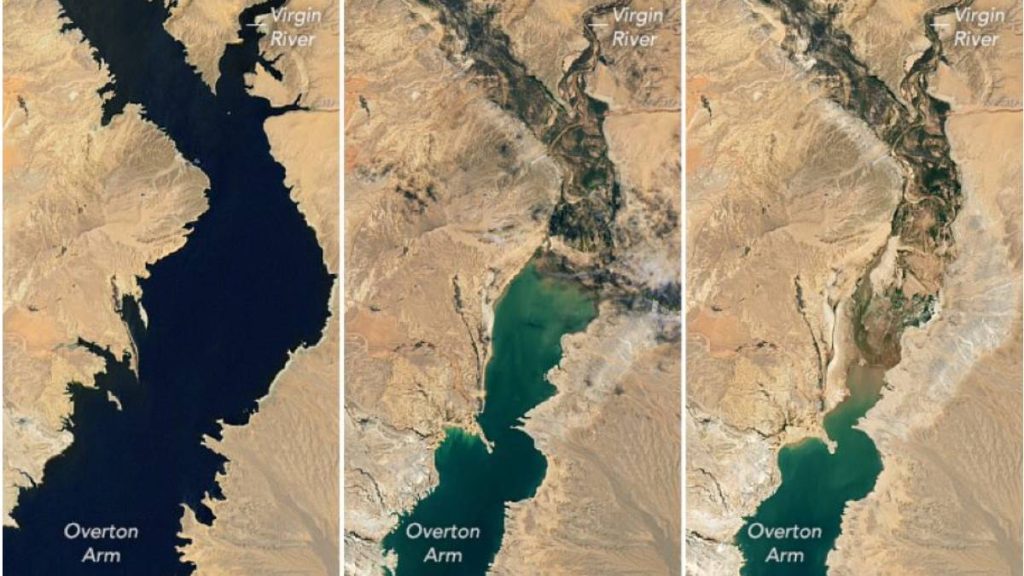The federal government and California’s water agencies recently signed an agreement to foster water conservation. The prime goal of the initiative is to help the water levels at Lake Mead maintain a steady rebound.

The US Bureau of Reclamation (USBR) manages Lake Mead, Lake Powell and a large portion of the Colorado River basin. Likewise, the USBR estimates that approximately 40 million Americans benefit from the Colorado River basin.
This may be in power supply from Hoover Dam or water supply to homes in basin states. These figures indicate how important the two lakes and the entire Colorado River basin can be.
Unfortunately, climate change has induced decade-long droughts in the region. So, the river shorelines are receding, while the water levels at Lake Mead and Lake Powell are steadily declining. In June 2022, data collection of water levels at Hoover Dam revealed an all-time low of 1043.02 feet.
ALSO READ: Panama Canal Gets So Clogged That Shipping Companies Are Bidding for Up to $4m to Cross
The drought-induced continuous drop of water levels in the reserves of the Colorado River basin has necessitated conservation initiatives. This is why the Federal government is liaising with California to cut water consumption. California water agencies are at the top of the USBR priority list because they consume the most water from the basin.
The water conservation deal involves the federal government giving an incentive of $295 million. The money will be in exchange for water conservation to the tune of 643,000 acre-feet at Lake Mead.
As of June 2022, Lake Mead’s water level was at its lowest in 22 years. This translated to the water in the US’s largest water reservoir dwindling at a miserly 27 percent capacity. For the Hoover Dam to generate hydroelectric power, the turbines require water levels above 1000 ft.
POLL — Is Climate Change a Major Threat That Requires Immediate Policy Action?
However, the 1043 ft level noted in June 2022 is a time bomb waiting to explode. In comparison, water at Lake Mead would reach 1225 ft at maximum capacity. It was at 1200 ft in the year 2001. However, water levels experienced a slight increase in 2023.
The implication is that the federal government and USBR need to take proactive steps to conserve water at the Lake Mead reservoir. Proactive water conservation in the Colorado basin will not only sidestep a power crisis. However, it will also help to regulate the water levels in the Colorado River basin. No one can tell how terrible the drought will get shortly.
ALSO READ: Judge Dismisses Lawsuit Disputing New Minnesota Law Restoring Felons’ Voting Rights
Besides water and power supply, the dwindling water levels have affected recreational activities in the area. The National Park Service states that Lake Mead is a designated national recreation area. It was a choice destination for boaters and windsurfers. Anyway, that was before the drought started biting really hard.
All hands are now on deck to conserve as much water resources as possible. The agreement with the water agencies of California is a step in the right direction. Likewise, five other states in the Colorado River basin are involved in the water conservation accord. So, states like Arizona, California, Nevada, and even the Imperial Irrigation District of Colorado are hopping on the water conservation train.
You Might Also Like This:
Residents Slam Chicago Lawmakers for Blocking Sanctuary City Status Vote
Democrats Clash as Greg Abbott Buses Migrants to Sanctuary Cities
Melania Trump Makes Rare Appearance, Welcomes New Citizens at National Archives Ceremony
Texas Gov. Greg Abbott Warns State Universities Against Advocating for Genocide or Antisemitism
Why Aren’t Teenagers Sexually Active? Here Are Top Reasons Why Teens Are Not Having Sex
